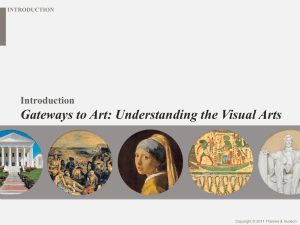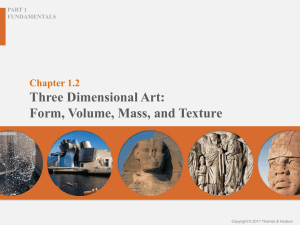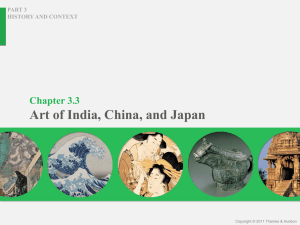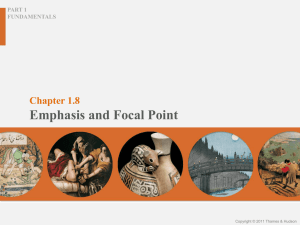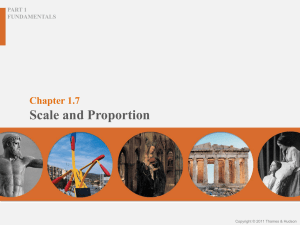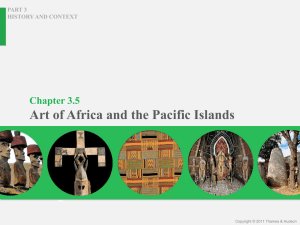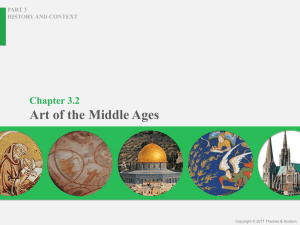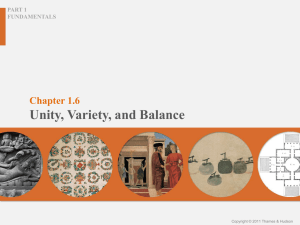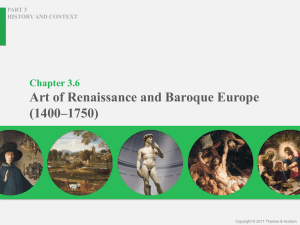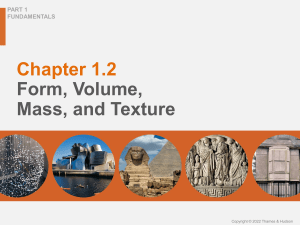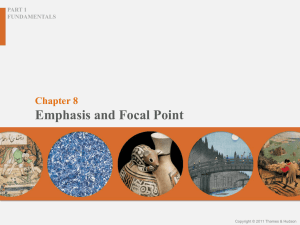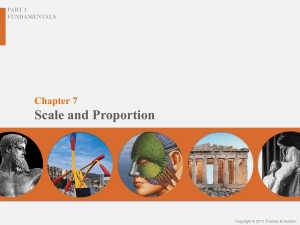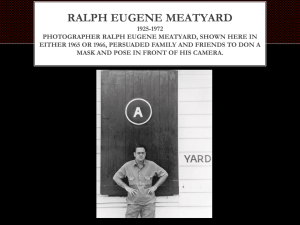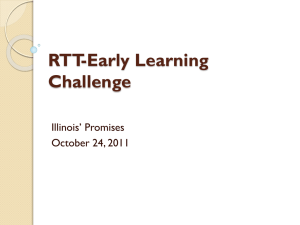Chapter 1.10 Gateways to Art: Understanding the Visual Arts By
advertisement
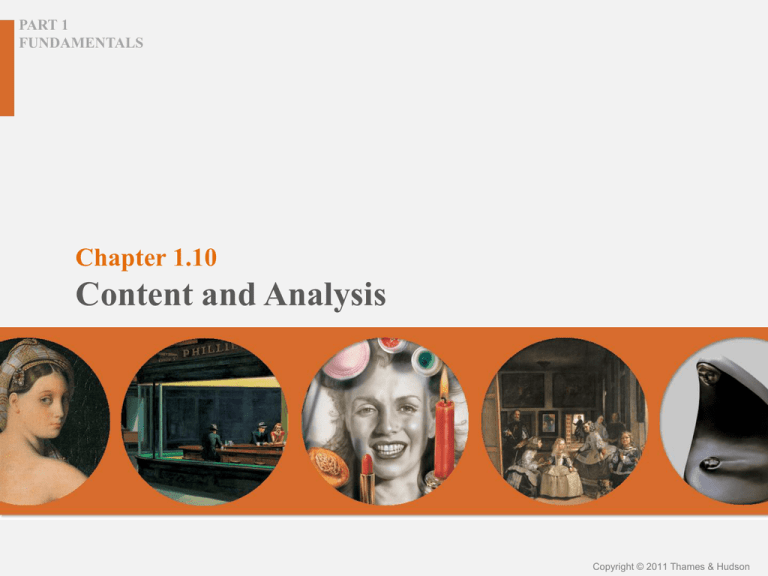
PART 1 FUNDAMENTALS Chapter 1.10 Content and Analysis Copyright © 2011 Thames & Hudson Chapter 1.10 Content and Analysis PART 1 FUNDAMENTALS Introduction The artist uses a visual language to communicate ideas, beliefs, emotions, and opinions Content: Subject Analysis: Finding meaning Imitation and individual style Learning from the masters Developing a unique style Gateways to Art: Understanding the Visual Arts, Debra J. DeWitte, Ralph M. Larmann, M. Kathryn Shields Chapter 1.10 Content and Analysis PART 1 FUNDAMENTALS Content Content refers to the meaning and the subject of a work of art Identifying the subject of an artwork: Representational (one can identify the subject) Non-objective (unrecognizable subject matter) Abstraction Gateways to Art: Understanding the Visual Arts, Debra J. DeWitte, Ralph M. Larmann, M. Kathryn Shields 1.161 Equestrian statue of Marcus Aurelius, c. 175 CE. Bronze, 11’6” high. Musei Capitolini, Rome, Italy 1.162 José de Rivera, Infinity, 1967. Stainless steel sculpture in front of National Museum of American History, Smithsonian Institution, Washington, D.C. 1.163 Allan Houser, Reverie, 1981. Bronze, 25 x 23 x 13”, edition of 10. Allan Houser Archives Chapter 1.10 Content and Analysis PART 1 FUNDAMENTALS Modes of Analysis Iconographic Biographical Feminist Contextual Psychological Formal (or visual) Gateways to Art: Understanding the Visual Arts, Debra J. DeWitte, Ralph M. Larmann, M. Kathryn Shields Chapter 1.10 Content and Analysis PART 1 FUNDAMENTALS Iconographic Analysis Interprets signs and symbols within an artwork Historical and religious references Gateways to Art: Understanding the Visual Arts, Debra J. DeWitte, Ralph M. Larmann, M. Kathryn Shields 1.164 Audrey Flack, Marilyn Monroe, 1977. Oil over acrylic on canvas, 8 x 8’. Collection of the University of Arizona Museum of Art, Tucson Chapter 1.10 Content and Analysis PART 1 FUNDAMENTALS Audrey Flack: Photorealism and Vanitas Click the image above to launch the video Gateways to Art: Understanding the Visual Arts, Debra J. DeWitte, Ralph M. Larmann, M. Kathryn Shields Chapter 1.10 Content and Analysis PART 1 FUNDAMENTALS Biographical Analysis Relates artist’s life and experiences to artwork Considers gender, race, nationality, and class Gateways to Art: Understanding the Visual Arts, Debra J. DeWitte, Ralph M. Larmann, M. Kathryn Shields 1.165 Eva Hesse, Hang-Up, 1966. Acrylic, cloth, wood, cord, and steel, 72 x 84 x 78”. Art Institute of Chicago Chapter 1.10 Content and Analysis PART 1 FUNDAMENTALS Feminist Analysis Role of women as: Artists Subjects Viewers Gateways to Art: Understanding the Visual Arts, Debra J. DeWitte, Ralph M. Larmann, M. Kathryn Shields 1.166 Jean-Auguste-Dominique Ingres, Grande Odalisque, 1814. Oil on canvas, 35⅞ x 63¾”. Musée du Louvre, Paris, France Chapter 1.10 Content and Analysis PART 1 FUNDAMENTALS Contextual Analysis Interprets artwork based on time and place in which it was made Considers historical, religious, political, economic, and social factors Gateways to Art: Understanding the Visual Arts, Debra J. DeWitte, Ralph M. Larmann, M. Kathryn Shields 1.167 Leni Riefenstahl, still from Triumph of the Will, 1934 Chapter 1.10 Content and Analysis PART 1 FUNDAMENTALS Psychological Analysis Considers the mental state of the artist when the artwork was being made and uses this to help interpret the work Gateways to Art: Understanding the Visual Arts, Debra J. DeWitte, Ralph M. Larmann, M. Kathryn Shields 1.168 Edward Hopper, Nighthawks, 1942. Oil on canvas, 33⅛ x 60”. Art Institute of Chicago Chapter 1.10 Content and Analysis PART 1 FUNDAMENTALS Formal Analysis Considers the elements and principles used by the artist Elements of art: line, shape, form, mass, volume, color, texture, space, time and motion, and value Principles of art: contrast, balance, unity, variety, rhythm, emphasis, pattern, proportion, and scale Gateways to Art: Understanding the Visual Arts, Debra J. DeWitte, Ralph M. Larmann, M. Kathryn Shields 1.169 Diego de Silva y Velázquez, Las Meninas, c. 1656. Oil on canvas, 10’5¼” x 9’¾”. Museo Nacional del Prado, Madrid, Spain 1.170 Detail of Diego de Silva y Velázquez, Las Meninas Chapter 1.10 Content and Analysis PART 1 FUNDAMENTALS What Is the Meaning of Las Meninas? Velázquez used Las Meninas to show his importance as a painter and his intimacy with the royal family Gateways to Art: Understanding the Visual Arts, Debra J. DeWitte, Ralph M. Larmann, M. Kathryn Shields Chapter 1.10 Content and Analysis PART 1 FUNDAMENTALS Diego Velázquez: Las Meninas Click the image above to launch the video Gateways to Art: Understanding the Visual Arts, Debra J. DeWitte, Ralph M. Larmann, M. Kathryn Shields Chapter 1.10 Content and Analysis PART 1 FUNDAMENTALS Imitation and Individual Style Artists often train themselves by studying and copying earlier masterpieces By referring to earlier masterpieces in new artworks, artists associate themselves with other artists who preceded them By studying other artworks, artists may learn how to differentiate themselves Gateways to Art: Understanding the Visual Arts, Debra J. DeWitte, Ralph M. Larmann, M. Kathryn Shields 1.171 Picasso, Las Meninas, first in a series, 1957. Oil on canvas, 6’4⅜” × 8’6⅜”. Museo Picasso, Barcelona, Spain Chapter 1.10 Content and Analysis PART 1 FUNDAMENTALS Comparison Compare the original Las Meninas by Velázquez with the reinterpretation by Picasso Gateways to Art: Understanding the Visual Arts, Debra J. DeWitte, Ralph M. Larmann, M. Kathryn Shields 1.172 Thomas Struth, Museo del Prado 7, 2005. Chromogenic print, 5’⅞” × 7’2” Chapter 1.10 Content and Analysis PART 1 FUNDAMENTALS Conclusion Artworks can be representational or non-objective; the degree to which they are non-objective is based upon the level of abstraction Best interpretations are based on synthesis of several modes of analysis Artists often look to earlier artists for inspiration Gateways to Art: Understanding the Visual Arts, Debra J. DeWitte, Ralph M. Larmann, M. Kathryn Shields Chapter 1.10 Content and Analysis PART 1 FUNDAMENTALS For a video that uses formal analysis, watch: Thomas Cole: The Oxbow Click the image above to launch the video Gateways to Art: Understanding the Visual Arts, Debra J. DeWitte, Ralph M. Larmann, M. Kathryn Shields Chapter 1.10 Content and Analysis PART 1 FUNDAMENTALS For a video that uses formal and contextual analysis, watch: Sandro Botticelli: The Birth of Venus Click the image above to launch the video Gateways to Art: Understanding the Visual Arts, Debra J. DeWitte, Ralph M. Larmann, M. Kathryn Shields Chapter 1.10 Content and Analysis PART 1 FUNDAMENTALS For a video that uses biographical and psychological analysis, watch: Vincent van Gogh in His Own Words Click the image above to launch the video Gateways to Art: Understanding the Visual Arts, Debra J. DeWitte, Ralph M. Larmann, M. Kathryn Shields Chapter 1.10 Content and Analysis PART 1 FUNDAMENTALS This concludes the PowerPoint slide set for Chapter 1.10 Gateways to Art: Understanding the Visual Arts By Debra J. DeWitte, Ralph M. Larmann, M. Kathryn Shields Copyright © 2011 Thames & Hudson PowerPoints developed by CreativeMyndz Multimedia Studios Chapter 1.10 Content and Analysis PART 1 FUNDAMENTALS Picture Credits for Chapter 1.10 1.161 iStockphoto.com 1.162 © Andia/Alamy 1.163 Allan Houser archives © Cliinde LLC 1.164 Collection University of Arizona Museum of Art, Tucson, Museum purchase with funds provided by the Edward J. Gallagher, Jr Memorial Fund 1982.35.1. © the artist 1.165 The Art Institute of Chicago, Gift of Arthur Keating and Mr. and Mrs. Edward Morris by exchange, April 1988. © The Estate of Eva Hesse. Hauser & Wirth. Photo Susan Einstein, courtesy The Art Institute of Chicago 1.166 Musée du Louvre, Paris 1.167 Courtesy Archiv LRP 1.168 The Art Institute of Chicago, Friends of American Art Collection, 1942.51 1.169 Museo Nacional del Prado, Madrid 1.170 Museo Nacional del Prado, Madrid 1.171 © Succession Picasso/DACS, London 2011 1.172 © 2012 Thomas Struth PowerPoints developed by CreativeMyndz Multimedia Studios
